Preparation and Characterization of ZnO NWs/Graphene Nanocomposite as an Effective Photoanode Electrode for Improving the Performance of the Dye-Sensitized Solar Cells
DOI:
https://doi.org/10.32792/utq/utjsci/v10i1.915Keywords:
ZnO NWs, Graphene, nanocomposite, Hydrothermal, DSSCsAbstract
In the present study, DSSCs were fabricated using pure ZnO NWs and ZnO NWs/Graphene nanocomposite as photoelectrodes. Graphene was incorporated into pure ZnO NWs through a cost-effective Hydrothermal Process to act as an electrical charge carrier. J-V curve of prepared nanocomposite was recorded with a light intensity of 100 mW.cm-2. The created nanocomposites were thoroughly investigated by using different electrical and structural characterization techniques such as SEM, XRD, and J-V characteristics. According to SEM examination, the ZnO NWs/graphene composite-based electrode has more porosity than the electrode made using pure ZnO NWs, which will increase the surface area and the amount of dye that can be absorbed. From the graphene advantages the reduced internal resistance and electron recombination loss, these properties allow electrons to transfer to the collection electrode efficiently. Based on these benefits, the ZnO NWs/Graphene nanocomposite photoanode with thickness of 965.11 nm that was used in the DSSC2 was demonstrated a Jsc of 19.50 mA.cm-2 and conversion efficiency of 9.829053%, which opposite to the result of the DSSC1 without graphene. These results can be encouraged for future improved optoelectronic devices.
Downloads
Published
License
Copyright (c) 2023 University of Thi-Qar Journal of Science

This work is licensed under a Creative Commons Attribution 4.0 International License.













